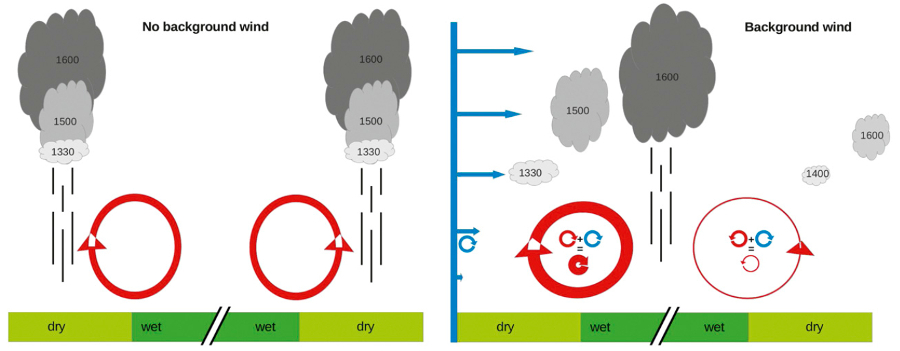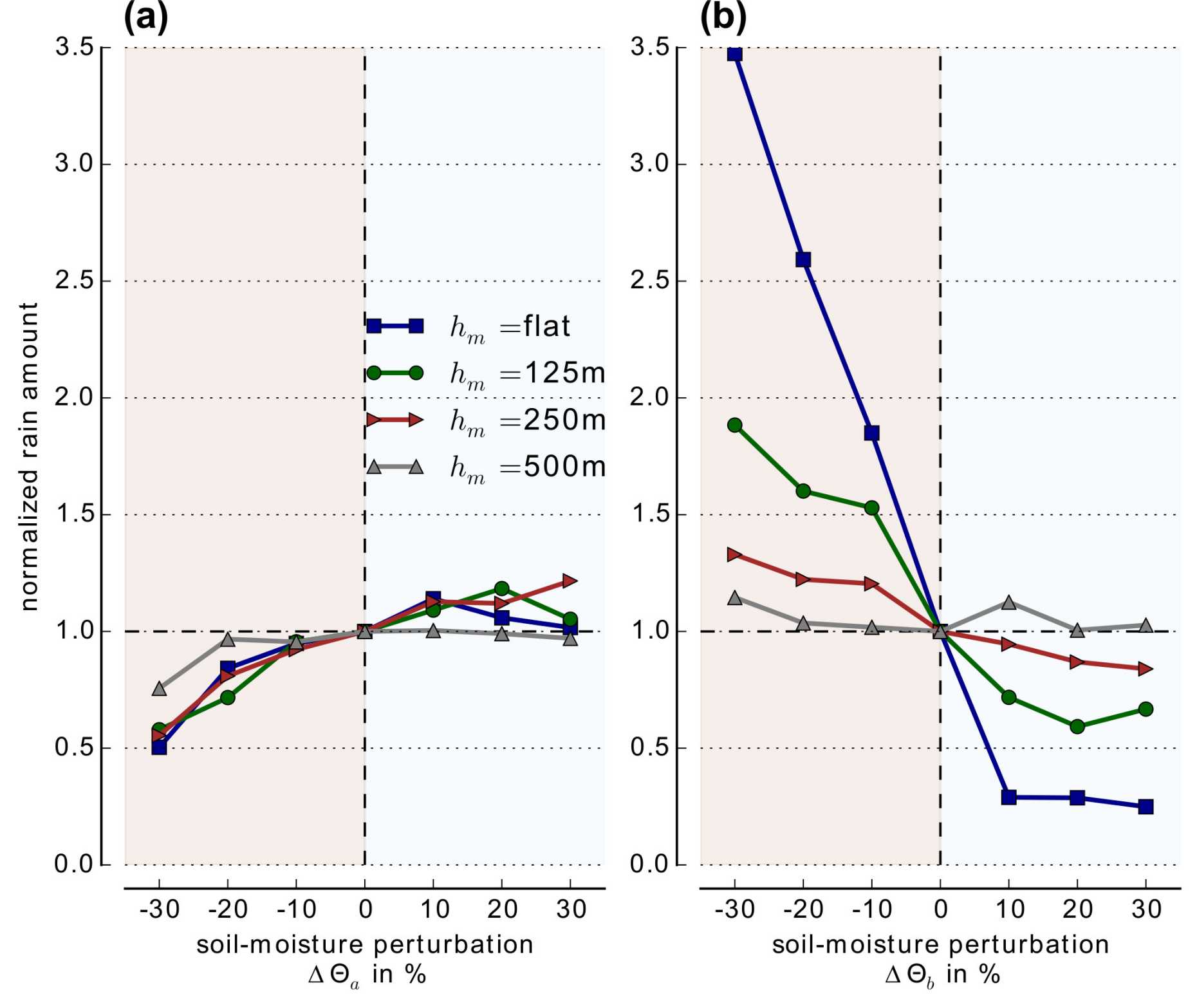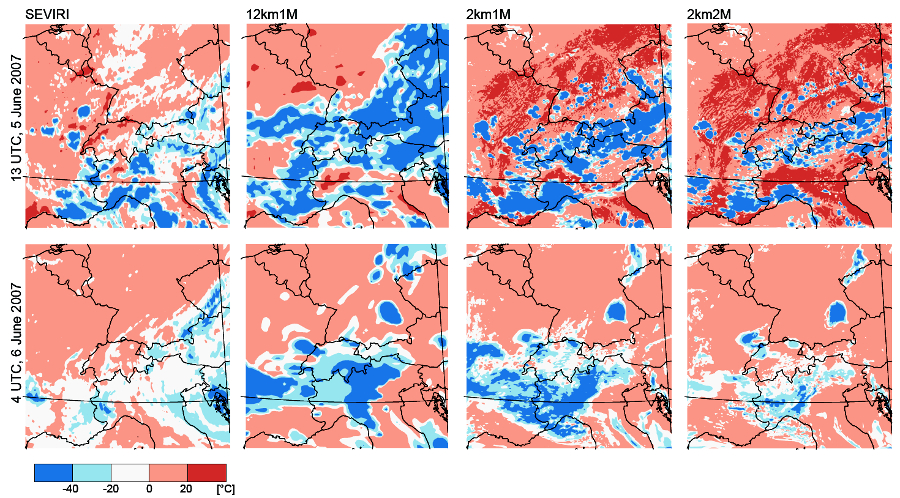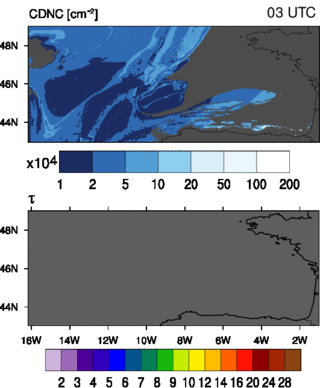Process Studies
The goal of this activity is to understand the key parameters that determine the characteristics of moist convection in the European summer climate and to investigate the sensitivity of these parameters to changes in future climates. This is done by reducing the complexity of the full earth system in idealized studies. Different settings covering present-day and future climates are addressed. In addition, the role of orography and soil-moisture inhomogeneity in triggering and organizing moist convection is investigated within idealized settings. The knowledge gained from these studies flows back into real-case climate studies.


The COSMO model is validated using satellite products from GERB, SEVIRI and AVHRR sensors, a raingauge-based precipitation data set and temperature measurements from surface stations. The validation is done for 12 km (convection-parameterizing model) simulations as well as 2 km (convection-resolving model) simulations. Radiative transfer models are used to generate synthetic satellite radiances. These synthetic satellite images are then compared to the observed satellite measurements. This approach benefits from a direct comparison of model states with observed states, without any assumptions about the observed atmosphere.

Ship tracks, which are characterized by recurring streak-line patterns of increased cloud albedo are often used as an illustrative example for aerosol-cloud effects. They are predominantly observed in stratocumulus regions with relatively shallow boundary layers along the worlds major shipping corridors. Although the radiative effect of ship emissions on a global scale is likely to be insignificant, they provide an ideal test bed for studying aerosol-cloud effects of stratiform boundary layer clouds. The ship exhaust particles are injected into pristine regions of very low aerosol concentrations, providing a large perturbation to the system where aerosol effects are distinguishable. At the regional 2-km scale, all involved processes rely on sub-gridscale parameterisations. Therefore this work contributes towards evaluating the contributing parameterisations (e.g. microphysics, turbulence, or radiation) and the interplay between them during track formation and maintenance.

Panosetti, D., L. Schlemmer, and C. Schär, 2018a: Convergence behavior of idealized convection-resolving simulations of summertime deep convection over land. Clim. Dyn., external pagehttps://doi.org/10.1007/s00382-018-4229-9call_made
Panosetti, D., L. Schlemmer, and C. Schär, 2018b: Bulk and structural convergence at convection-resolving scales in real-case simulations of summertime moist convection over land. Quart. J. Roy. Meteor. Soc., under review.
Imamovic, A., Schlemmer, L., & Schär, C. (2017). Collective impacts of orography and soil moisture on the soil moisture‐precipitation feedback. Geophysical Research Letters, 44, 11,682–11,691. external pagehttps://doi.org/10.1002/2017GL075657call_made
Panosetti, D., S. Böing, L. Schlemmer, and J. Schmidli (2016): Idealized large-eddy and convection-resolving simulations of moist convection over mountainous terrain. J. Atmos. Sci., 73, 4021–4041, external pagehttps://doi.org/10.1175/JAS-D-15-0341.1call_made
Possner, A.,E. Zubler., U. Lohmann, and C. Schär (2015) : Real-case simulations of aerosol–cloud interactions in ship tracks over the Bay of Biscay, Atmos. Chem. Phys., external pagedoi:10.5194/acp-15-2185-2015call_made
Keller, M., Fuhrer, O., Schmidli, J., Stengel, M., Stöckli, R. and Schär, C. (2015): Evaluation of convection-resolving models using satellite data: The diurnal cycle of summer convection over the Alps, Meteorologische Zeitschrift, external pagedoi: http://doi.org/10.1127/metz/2015/0715call_made
Froidevaux, P., L. Schlemmer, J. Schmidli, W. Langhans, and C. Schär (2014): Influence of the background wind on the local soil-moisture precipitation feedback, J. Atmos. Sc., external pagedoi: http://dx.doi.org/10.1175/JAS-D-13-0180.1call_made
Langhans, W., J. Schmidli, C. Schär (2012) Bulk Convergence of cloud-resolving simulations of moist convection over complex terrain, J. Atmos. Sc., external pagedoi: http://dx.doi.org/10.1175/JAS-D-11-0252.1call_made
Schlemmer, L., C. Hohenegger, J. Schmidli, C. Bretherton, and C. Schär (2011): An idealized cloud-resolving framework for the study of summertime midlatitude diurnal convection over land, J. Atmos. Sci., external pagedoi: http://dx.doi.org/10.1175/2010JAS3640.1call_made
